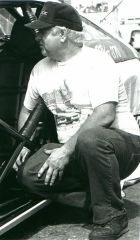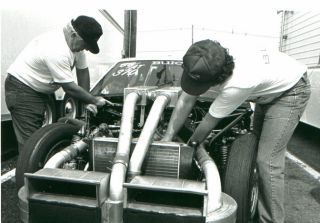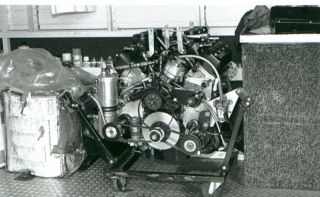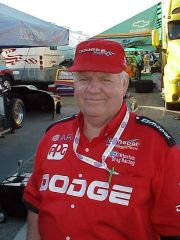Six Bangin'
The Day A Twin-turbocharged V-6 Ran Pro Stock
Photos by
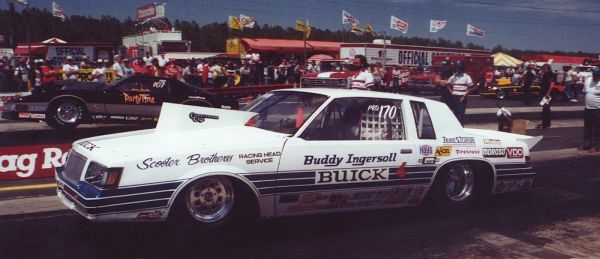
If there was an era that the world of Pro Stock took a step towards greatness and looked over the edge, it was certainly in 1986. Now many of you might contend that Pro Stock now is as far along the cutting edge as it ever has been. We'll tend to disagree. During that incredible season some 15 years ago, the IHRA Pro Stock program got a glimpse of the future and it scared the bejesus out of them. A class that had always prided itself of not following the norm was doing business as usual. When NHRA was mired in the pounds per cubic inch debate, the Bristol, Tenn.-based sanctioning body had stepped up with a mountain motor program, which made engine size limitless. However, mountain motors didn't send near the chill up their spine that a twin-turbocharged, 262-inch Buick V-6 would end up doing.
|
The IHRA allowed Ingersoll to have a place to run his machine, after the NHRA had pondered the idea and declined. Ingersoll's machine was cutting edge technology under the hood, despite his car being an ex-Warren Johnson Oldsmobile Cutlass that was redesigned into a Buick Regal. The real selling point on the cosmetically crafted Regal was the engine produced by McClaren Engines and the Buick V-6 Indy program. Indy car technology was knocking on the door of drag racing and really wanted someone to answer.
"The people at Buick talked to NHRA about running a V-6, because it was a stock V-6," explained Ingersoll, a former NHRA Modified World Champion. "NHRA said that if you can make it competitive we will let you run it. The first year we ran it, it was about .15 to .20 too slow. NHRA came back and said if you can get it to a certain time, back then I think it was 7.60's, and the next year we got it to run that fast. Then they had the Pro Stock association and they all lobbied, cried and screamed about letting me run in it. Buick engineers called NHRA to set up a meeting to get it to run Pro Stock. When the engineers got to the meeting no one from NHRA showed up, so they decided not to let me run."
That's when the IHRA, always the opportunist, seized the day. They allowed Ingersoll's Buick to run as a Pro Stock among the behemoth engines of Pro Stock. At first, the team struggled and failed to qualify at the first few events. But, when they did get the program together, the silence that fell over the pits was one that allowed a pin drop to be heard.
Ingersoll, once mired in the 7.90s when the class was running in the 7.30/195 mph hour range broke out of his shell and used the final event of the 1986 season as his springboard. He leapt to the front of qualifying with a 7.20 at nearly 198 miles per hour. The fans in attendance at the 1986 WCYB Fall Nationals in loved him, but his competition was less than impressed.
Ingersoll waded his way through the first two rounds with no real challenges, but the firestorm really began in the semi-finals when multi-time winner Rickie Smith left on Ingersoll and he quickly tracked him down despite a large defecit. He even won the race by a substantial margin.
|
Smith was none too pleased with what had transpired. It appeared to Ingersoll that his participation was always welcomed as long as he didn't run competitively.
"Yes Rickie was the one who started it all this trouble about it," confided Ingersoll. "This is second hand information so I didn't see any of it, I don't know if any of this is true. The former head of IHRA, Ted Jones told me that they would let me run if they could find a sponsor for their television show. But if Ford had to do it, it wasn't going to float. Ford said that if they let me run they wouldn't sponsor the television program. If IHRA could find someone else to sponsor the television programming that they would, the fans really liked it but we needed the television program."
Ingersoll continued, "When I outran Rickie was when all the problems started. After that, Glidden told me that Ricky was crying really hard and trying to get me thrown out. Like I said though it is all second hand stuff so I don't put a lot in it, because the fans really liked it and so did IHRA. I still have fans come up and say that they remember that."
|
Smith couldn't be reached to comment on this article, but had expressed his adamant opposition to the whole scenario. One of his more memorable comments was, "It was unfair to us because we didn't have anything to turn up the wick on our machines like he could do with the turbos."
The IHRA allowed the turbos because they felt that since the car's engine size was a third of the others, that it would be an equalizing factor. Jones later admitted that maybe they had made a mistake. Others contend that they surrendered to the threats of potentially withdrawing sponsors.
"Buddy and Buick had a legitimate argument, he had a car that you could buy from Detroit and wondered why he couldn't run it," explained Jones, who was the IHRA Vice-President at the time. "He ran well and did very good, but the real problem is that he laid down a few passes that scared the fire out of the V-8 guys. We caught a lot of heat over that. They contended that if he ever got the turbo down pat that they didn't have a prayer. The odd part is that he never won a race."
He continued, "It wasn't Ford that gave us the heat, it was the other racers. Everybody was up in arms. They didn't have a problem with the V-6. It was the turbochargers. The V-8 guys wanted one too. We couldn't do it. We saw that it could have gotten out of hand. We knew that there could have been limiting factors, but we didn't want to go there. It was too much of a hassle. We did let him finish the year."
Ingersoll wouldn't concede that the discontinuation of his combination stunted the growth of Pro Stock, but he was disappointed that it didn't remain part of the program.
|
"No, Pro Stock is going to keep going and growing," explained Ingersoll. "It was something that a lot of people knew about and followed it. It is just like anything else some days you get to do things, and other days NHRA tells you, you can't. In this case, it was the IHRA. We hated that it didn't work out."
Ingersoll continued his turbo program for a year or two and when Buick pulled out, his interest waned. Does he still remain involved?
"No, a few years after that I talked with a few people, and told them what to do with their programs," explained Ingersoll. "Then I had a job offer to go over seas and work for Mitsubishi, on their Turbo racing stuff, but never did go. They called several times though, I did some consulting work for them but never went to work in their stuff."
He added, "I don't know that turbo cars are cheaper to run. I thought about running it in Alcohol Dragster, because you could run two of them, in the same class as the big motors run, you could run two V-6's. The advantage of it would be, it would make the same power if not more, but you wouldn't have to take it apart after each run. You could put 50 runs on a Turbo Charged car and never pull a pin or nothing on it. It just doesn't hurt that much stuff. You wouldn't have all the maintenance, if you had everything right. A Turbo isn't really that hard on parts. It takes power turn those blowers, but with a Turbo it is all free power, it doesn't cost you anything motor wise to make that much power."
Ingersoll doesn't plan to ever return to the combination because it just isn't worth the effort.
|
Ingersoll contends, "It would take a lot to get them to run. If they ran then the people that didn't want them to run would make sure that they couldn't run. Plus, it is fun to do all of that stuff, but now in racing it is so expensive. It's not worth trying to fight people to do it."
With the EFI talk, he feels the time is right for such a change. He understands that his deal way too ahead of its time. He harbors no resentment, though.
"We'll they have been talking about that for years," Ingersoll said. "When they go to E.F.I. it will just be that some of the factory people will have a big advantage, because they will be able to do more with it than normal. The normal Pro Stock and Pro Stock Truck don't have the equipment or the expertise to have the E.F.I. However, the guys that do have the factory set-ups and the factory backing are going to have the big advantage."
He added, "I'm not bitter about the deal. I've had a lot of fun racing different people, not only the Pro Stock guys. I really did like running heads up with people. I've run a lot of fast cars. My V-6 was fast and I had fun beating a lot of people. I especially had a lot of fun that day in Bristol. Every time you pull to the line and beat some one- it is fun."
Ingersoll had the opportunity on that September day of 1986 to establish himself in the record books by becoming the only driver to ever win a Pro Stock race in the two major sanctioning bodies with a V-6. He fell short in the final against Bob Glidden. Glidden posted a 7.282/193.96, which easily topped Ingersoll's slowing 7.371/189.07.
After all these years of speculation as to whether Ingersoll let up intentionally to preserve his combination's legality in Pro Stock, Ingersoll finally told the bottom line.
Did he lift and allow Glidden to win?
"Heck no," he answered with a serious look on his face.
He added, "Anybody that knows me, knows that I race to win, I don't let up for anybody. I'll out run anyone I can. I don't think I would let up if my wife was in the other lane."
